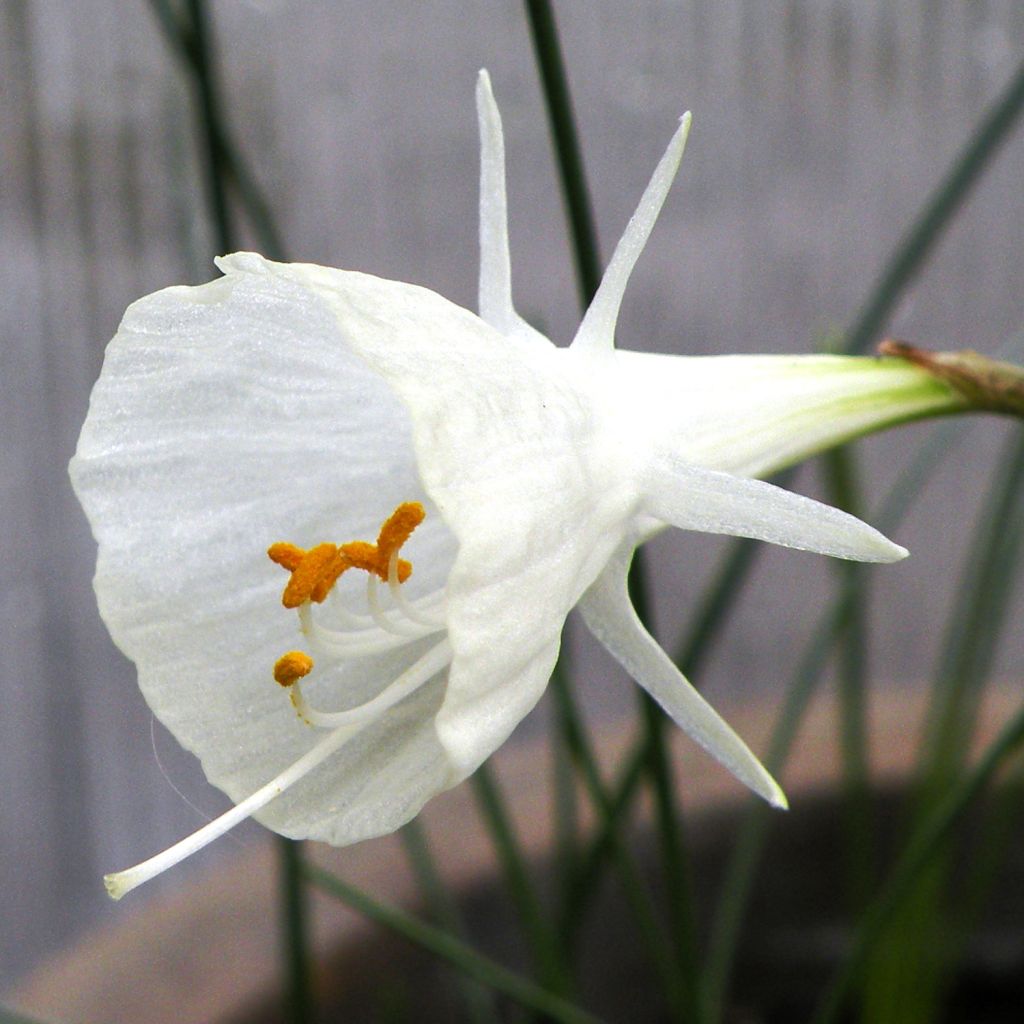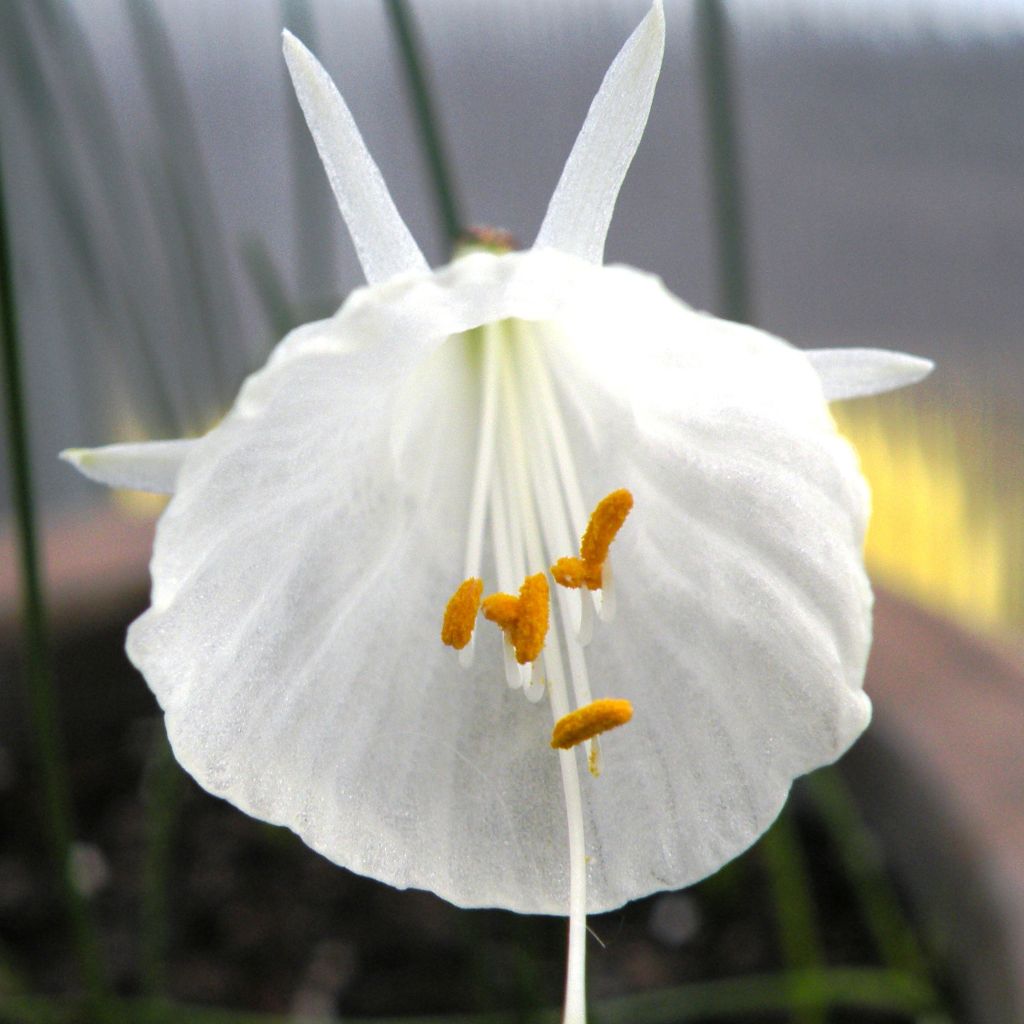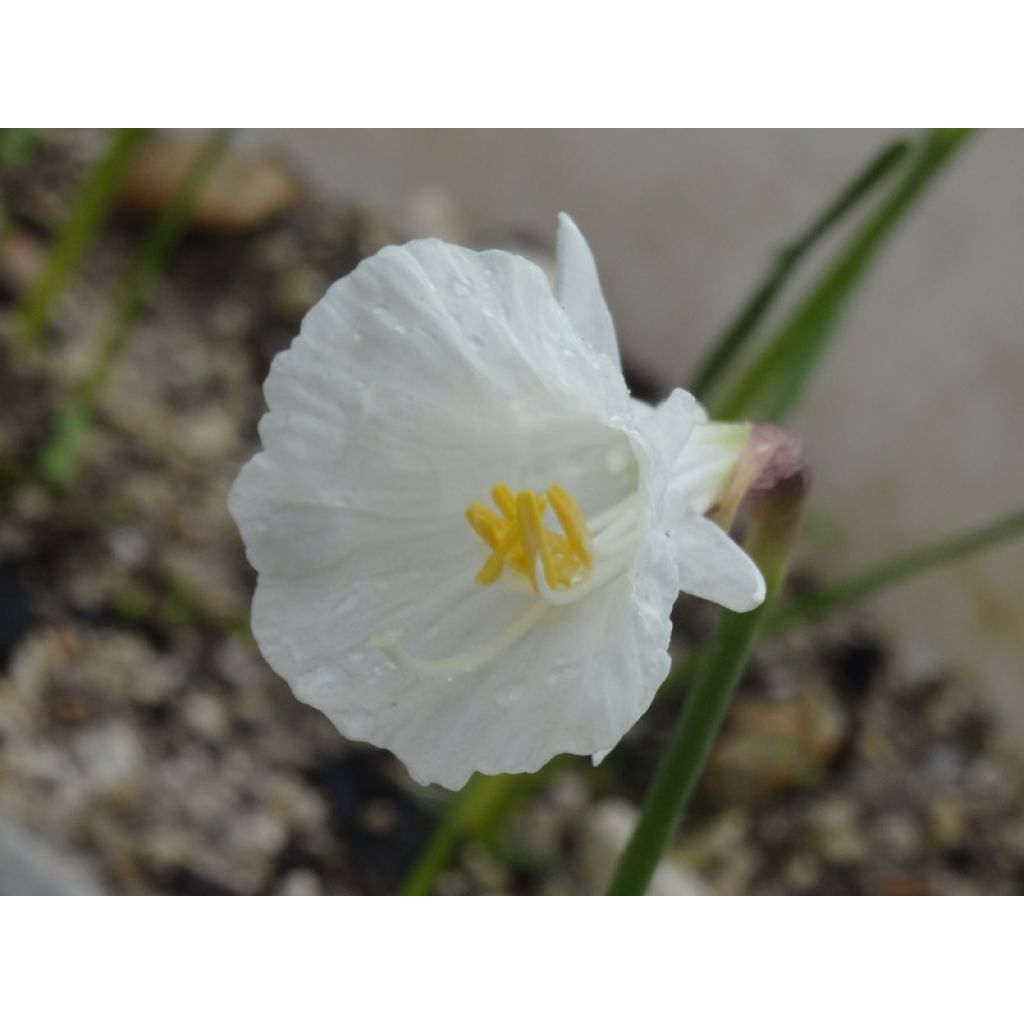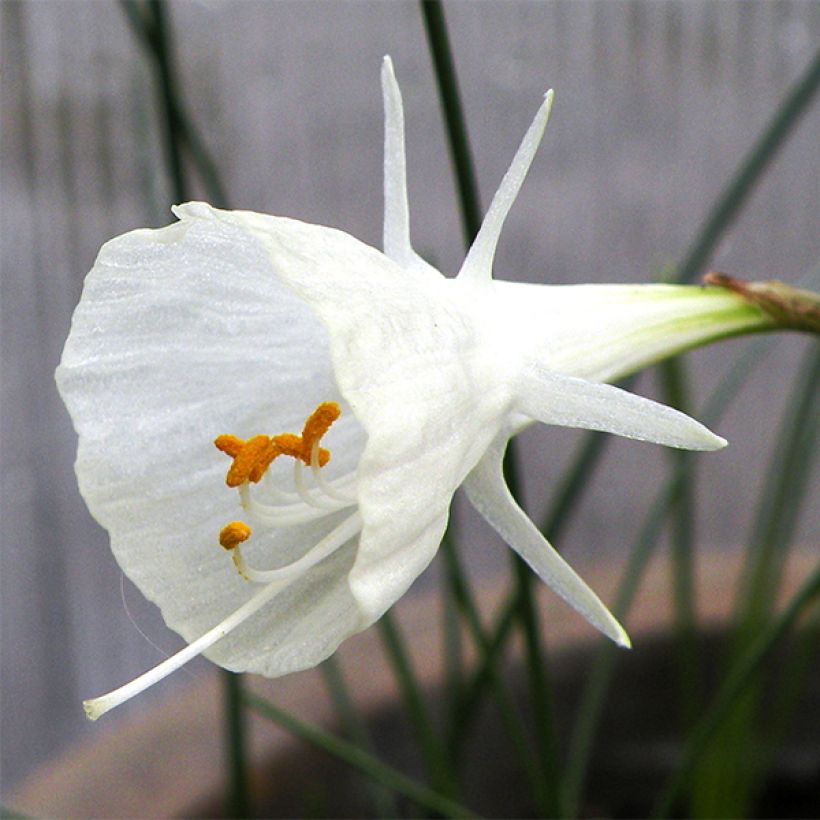

Narcisse bulbocodium White


Narcisse bulbocodium White


le premier à fleurir au jardin
Narcissus x bulbocodium cantabricus
Narcissus x bulbocodium Cantabricus
White hoop petticoat daffodil
Patience, patience.
Claudine W., 12/10/2018
This plant carries a 6 months recovery warranty
More information
We guarantee the quality of our plants for a full growing cycle, and will replace at our expense any plant that fails to recover under normal climatic and planting conditions.
From €5.90 for pickup delivery and €6.90 for home delivery
Express home delivery from €8.90.
Does this plant fit my garden?
Set up your Plantfit profile →
Description
Narcissus x bulbocodium cantabricus is a small daffodil, rarely offered in commerce. It bears unusual white flowers, composed of a swollen central corona in the shape of a crinoline. This hoop emerges from a discreet crown of 6 very thin sepals. This bulbous plant sometimes blooms as early as November in mild climates, and in February-March in cooler climates. It is not very hardy (-10°C (14°F)), but adapts to heat and summer drought. To successfully grow it, provide it with sun and well-drained soil that is moist to dry in summer. It often self-sows in light soil or in rock gardens. This hooped-petticoat daffodil is ideal for potted displays in the heart of winter.
Narcissus bulbocodium, also known as crinoline daffodil or medusa's trumpet, belongs to the Amaryllidaceae family. It is a common species in the western Mediterranean, from Morocco to Spain, and south of France, particularly in Languedoc Roussillon and Gironde. It is often found in limestone soil. Narcissus x bulbocodium cantabricus is sometimes suspected to be a crossbreed with N. cantabricus. It is drought-resistant and prolific. It does not exceed 10cm (4in) in height when in bloom. Its flowers, measuring 2.8 to 4.5cm (1 to 2in) in diameter, are composed of a corolla of modest, very thin petals, on which a wide and swollen corona is inserted, almost completely eclipsing the small crown of petals. It is an early-flowering plant, capable of blooming as early as the second half of February when well-established, and even in autumn in favourable climates. The delicate foliage, which can be mistaken for tender grass, is deciduous in summer. In mild climates, it develops with the first rains in September and persists in winter. This variety easily multiplies through spontaneous sowing and production of bulblets, from an ovoid bulb the size of a hazelnut.
Narcissus x bulbocodium cantabricus grows in any well-drained and loosened, humus-rich soil, but results are less satisfactory in excessively moist or acidic soils.
There are so many daffodil cultivars that one can enjoy them for three months in spring without ever getting tired. They all have in common the ability to naturalise easily, to offer an infinite range of yellow and white shades, and to often emit sweet fragrances. Grow them in large clumps in lawns or at the edge of flower beds (at least 20 bulbs) for an enhanced effect. Pair it with squills, hyacinths, early-blooming botanical tulips, botanical crocuses, forget-me-nots, pansies, or liverworts. This daffodil is also perfect in pots.
Report an error about the product description
Narcissus x bulbocodium cantabricus in pictures


Plant habit
Flowering
Foliage
Botanical data
Narcissus
x bulbocodium
Cantabricus
Amaryllidaceae
White hoop petticoat daffodil
Mediterranean
Planting and care
This daffodil grows happily in well-drained and loosened soil that is moist during the growing season but rather dry in summer. It also prefers calcareous soils. Plant the bulbs from September to mid-December, at a depth of 8cm (3in), with a spacing of 8cm (3in), in a sunny exposure. Do not disturb them, and every year your narcissus will produce more and more flowers. It is not recommended to water in summer, even in dry and hot climates. The bulbs remain in the ground. Remove the faded flowers to prevent the bulb weakening from seed production. You can cut the foliage once it has withered and turned yellow.
If the clumps become dense and less floriferous, they can be divided from July to September when the leaves are dry. Replant the bulbs immediately, discarding any damaged ones.
Cultivation in pots
Bulbs grown in pots can be repotted in late summer. Take the opportunity to check the condition of the bulbs, which should not show any signs of rot. Place them in a mixture rich in gravel and clay. Use a potassium-rich fertiliser, specifically for bulbs, which you will dilute with water (dilute the prescribed dose by the manufacturer). Water during the growing season, but stop watering in summer.
Planting period
Intended location
Care
-
, onOrder confirmed
Reply from on Promesse de fleurs
Haven't found what you were looking for?
Hardiness is the lowest winter temperature a plant can endure without suffering serious damage or even dying. However, hardiness is affected by location (a sheltered area, such as a patio), protection (winter cover) and soil type (hardiness is improved by well-drained soil).

Photo Sharing Terms & Conditions
In order to encourage gardeners to interact and share their experiences, Promesse de fleurs offers various media enabling content to be uploaded onto its Site - in particular via the ‘Photo sharing’ module.
The User agrees to refrain from:
- Posting any content that is illegal, prejudicial, insulting, racist, inciteful to hatred, revisionist, contrary to public decency, that infringes on privacy or on the privacy rights of third parties, in particular the publicity rights of persons and goods, intellectual property rights, or the right to privacy.
- Submitting content on behalf of a third party;
- Impersonate the identity of a third party and/or publish any personal information about a third party;
In general, the User undertakes to refrain from any unethical behaviour.
All Content (in particular text, comments, files, images, photos, videos, creative works, etc.), which may be subject to property or intellectual property rights, image or other private rights, shall remain the property of the User, subject to the limited rights granted by the terms of the licence granted by Promesse de fleurs as stated below. Users are at liberty to publish or not to publish such Content on the Site, notably via the ‘Photo Sharing’ facility, and accept that this Content shall be made public and freely accessible, notably on the Internet.
Users further acknowledge, undertake to have ,and guarantee that they hold all necessary rights and permissions to publish such material on the Site, in particular with regard to the legislation in force pertaining to any privacy, property, intellectual property, image, or contractual rights, or rights of any other nature. By publishing such Content on the Site, Users acknowledge accepting full liability as publishers of the Content within the meaning of the law, and grant Promesse de fleurs, free of charge, an inclusive, worldwide licence for the said Content for the entire duration of its publication, including all reproduction, representation, up/downloading, displaying, performing, transmission, and storage rights.
Users also grant permission for their name to be linked to the Content and accept that this link may not always be made available.
By engaging in posting material, Users consent to their Content becoming automatically accessible on the Internet, in particular on other sites and/or blogs and/or web pages of the Promesse de fleurs site, including in particular social pages and the Promesse de fleurs catalogue.
Users may secure the removal of entrusted content free of charge by issuing a simple request via our contact form.
The flowering period indicated on our website applies to countries and regions located in USDA zone 8 (France, the United Kingdom, Ireland, the Netherlands, etc.)
It will vary according to where you live:
- In zones 9 to 10 (Italy, Spain, Greece, etc.), flowering will occur about 2 to 4 weeks earlier.
- In zones 6 to 7 (Germany, Poland, Slovenia, and lower mountainous regions), flowering will be delayed by 2 to 3 weeks.
- In zone 5 (Central Europe, Scandinavia), blooming will be delayed by 3 to 5 weeks.
In temperate climates, pruning of spring-flowering shrubs (forsythia, spireas, etc.) should be done just after flowering.
Pruning of summer-flowering shrubs (Indian Lilac, Perovskia, etc.) can be done in winter or spring.
In cold regions as well as with frost-sensitive plants, avoid pruning too early when severe frosts may still occur.
The planting period indicated on our website applies to countries and regions located in USDA zone 8 (France, United Kingdom, Ireland, Netherlands).
It will vary according to where you live:
- In Mediterranean zones (Marseille, Madrid, Milan, etc.), autumn and winter are the best planting periods.
- In continental zones (Strasbourg, Munich, Vienna, etc.), delay planting by 2 to 3 weeks in spring and bring it forward by 2 to 4 weeks in autumn.
- In mountainous regions (the Alps, Pyrenees, Carpathians, etc.), it is best to plant in late spring (May-June) or late summer (August-September).
The harvesting period indicated on our website applies to countries and regions in USDA zone 8 (France, England, Ireland, the Netherlands).
In colder areas (Scandinavia, Poland, Austria...) fruit and vegetable harvests are likely to be delayed by 3-4 weeks.
In warmer areas (Italy, Spain, Greece, etc.), harvesting will probably take place earlier, depending on weather conditions.
The sowing periods indicated on our website apply to countries and regions within USDA Zone 8 (France, UK, Ireland, Netherlands).
In colder areas (Scandinavia, Poland, Austria...), delay any outdoor sowing by 3-4 weeks, or sow under glass.
In warmer climes (Italy, Spain, Greece, etc.), bring outdoor sowing forward by a few weeks.


































